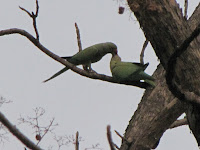Now why this theatrical drift? Coz it strangely got me (re) connected to the quantum oneness of all that cosmos holds and beholds, inside which our observations were to unfold during the next 5 days, as we set open 9 windows, which the Biomimicry lady- Janine Benyus, describes in her book- Innovations Inspired from Nature - as nature’s laws, strategies, and principles that resonates in all that exists, in both visible and invisible paradigms. According to her, “Life has some very universal, common strategies- that it uses across the board simply because they work so well”, I have all the reasons and, if need be- the willingness to unlearn to believe that.
Not drifting any further – the 9 laws, for the next 5 days at Tadoba national park, oh, sorry- Tadoba Tiger Reserve, were to be sanctified as a musician would do to the 7 notes of music. It was not about looking for logics and explanations on why 9 and why only 9, but to seek examples, to practice and balance the scale of 9, to tune our senses and orient our thinking, to take back building material for ideas and its applications, or simply to observe as never before.
Following is the summary of our findings, with an earnest attempt to not dilute your observations while you are at your findings when next in a forest:
1. Nature runs on Sunlight: Now isn't that one of the most obvious and central to life's existence phenomenon?
But to revisit this knowledge as a Principle, perhaps gives an access to observe it as a brilliant mechanism in use both by organic and inorganic to 'run on sunlight'. Run- which also indicates a cyclic formation, a recurring phenomenon, self-sustaining and thus abundant, like the life-nurturing photosynthesis.
This time at Tadoba forest (April), flawlessly demonstrates what it takes to be known as 'dry deciduous'. Bare trees with sketched branches, shedding off the greens. Greens that run on sunlight, incessantly manufacturing all that is required for nurturing growth. Interestingly, the same star, also enables the mechanism to shed off. Perhaps, the reason for leaves to be known as 'leaves' with a promise to come back, giving the forest an almost upside down scattered canopy, as all the greens- now dried and brown, work as a fantastic insulation to retain ground water and also harvest dew to refill quenching portion of what got evaporated.
1. Nature runs on Sunlight: Now isn't that one of the most obvious and central to life's existence phenomenon?
But to revisit this knowledge as a Principle, perhaps gives an access to observe it as a brilliant mechanism in use both by organic and inorganic to 'run on sunlight'. Run- which also indicates a cyclic formation, a recurring phenomenon, self-sustaining and thus abundant, like the life-nurturing photosynthesis.
This time at Tadoba forest (April), flawlessly demonstrates what it takes to be known as 'dry deciduous'. Bare trees with sketched branches, shedding off the greens. Greens that run on sunlight, incessantly manufacturing all that is required for nurturing growth. Interestingly, the same star, also enables the mechanism to shed off. Perhaps, the reason for leaves to be known as 'leaves' with a promise to come back, giving the forest an almost upside down scattered canopy, as all the greens- now dried and brown, work as a fantastic insulation to retain ground water and also harvest dew to refill quenching portion of what got evaporated.
2. Nature uses only the energy it needs: Nothing can beat this evolutionary mechanism when it comes to energy management. A tree's ability to strategically prevent 'growth' due to lack of water,
Langurs using trees' kinetic energy by springing from one branch to the other.
 The Sambars seem to be well aware of this phenomenon, and thus dare to play safe in the same pond inhabiting the tigresses.
The Sambars seem to be well aware of this phenomenon, and thus dare to play safe in the same pond inhabiting the tigresses.
Using this Principle as a default mechanism, Crocodiles are built to last! With a body mass that exceeds 4 tons, crocodiles can control their metabolic rate; they can slow their heart down to only two or three beats a minute when they are inactive, and can widen or narrow their blood vessels to limit or increase blood and oxygen supply to peripheral parts of the body as and when needed.
In addition, being "cold-blooded", they don't use metabolic energy to maintain their body temperature. All this enables them to survive for long periods without eating at all; big crocodiles can go for more than a year without feeding and even new hatchlings can survive for four months on the fat from the remains of the yolk-sac. No surprise how they outlived the dinosaurs.
 Form in nature is material science for us. The beak of a Parakeet is built to eat, chew, feel, preen, feed, hold objects and defend.
Form in nature is material science for us. The beak of a Parakeet is built to eat, chew, feel, preen, feed, hold objects and defend. The Tiger- a form perfectly fit to be on the apex- robust built, honed focus, agile yet discreet, stealthily camouflaged. All brilliantly performing as synchronized tools to function as a shrewd hunter. Interestingly, forms outwit forms, giving a counter edge to all that one species banks upon. Rule to survive.

4. Nature Recycles everything : and this is so intrinsically performed that nothing is kept out of the loop. A closed loop recycle system- soil to minerals- minerals to roots, roots to sap- sap to stems- stems to leaves- leaves back to soil and the show goes on.
5. Nature rewards cooperation by default, as there is nothing that species do for each other that is not rewarding. hm. That explains quite a lot. Pollination, seed-dispersal, survival calls, local travels, free dentistry, regular pest control and the list is endless. thankfully!

 Look on to your left, the crowded sky of canopy yet cooperating enough space for growth.
Look on to your left, the crowded sky of canopy yet cooperating enough space for growth.
And the hungry butterfly below getting rewarded by the nectar luring flower.
6. Nature banks on diversity:

 Look on to your left, the crowded sky of canopy yet cooperating enough space for growth.
Look on to your left, the crowded sky of canopy yet cooperating enough space for growth. And the hungry butterfly below getting rewarded by the nectar luring flower.
6. Nature banks on diversity:
How often have we really thanked to be born in a Tropical region? Never, I know, because we never correlate the sultry weather as one of the ruling factors for the diversity that we are endowed with.
As a matter of fact, diversity banks on diversity, just for example- the world of birds- as many types that many beaks and and claws and those many seeds dispersal and pest control and food chain and what not! Look at the photos and dare to disagree :)



7. Nature demands local expertise

 8. Nature curbs excesses from within
8. Nature curbs excesses from within
An inherently inbuilt mechanism at play to ensure survival, sustainability and sustenance. Tiger at the apex naturally controlling the prey-base, sloth bears feasting on bee hives ensuring sustenance through pollination, parched trees shedding off leaves, cold-blooded reducing their metabolic activity, in fact the best one observed was the pair of wild-dogs, who even pruned ‘excess’ hair cover to keep off heat!
9.Nature taps the power of limits
This is one of the most beautifully explained laws of all, in Janine’s words, “is perhaps the most opaque to us because we humans regard limits as a universal dare, something to overcome so we can continue our expansion. Other Earthlings take their limits more seriously, knowing they must function within a tight range of life-friendly temperatures, harvest within the carrying capacity of the land, and maintain an energy balance that cannot be borrowed against. Within these ‘limits’, life unfurls her colours with virtuosity, using limits as a source of power, a focusing mechanism. Because nature spins her spell in such a small space, her creations read like a poem that says only what it means”.
All these collectively conclude, what Beethoven once poetically exclaimed on a music page:
happy every one
in the Woods
every Tree speaks
through thee!











1 comment:
Nice write-up
Post a Comment